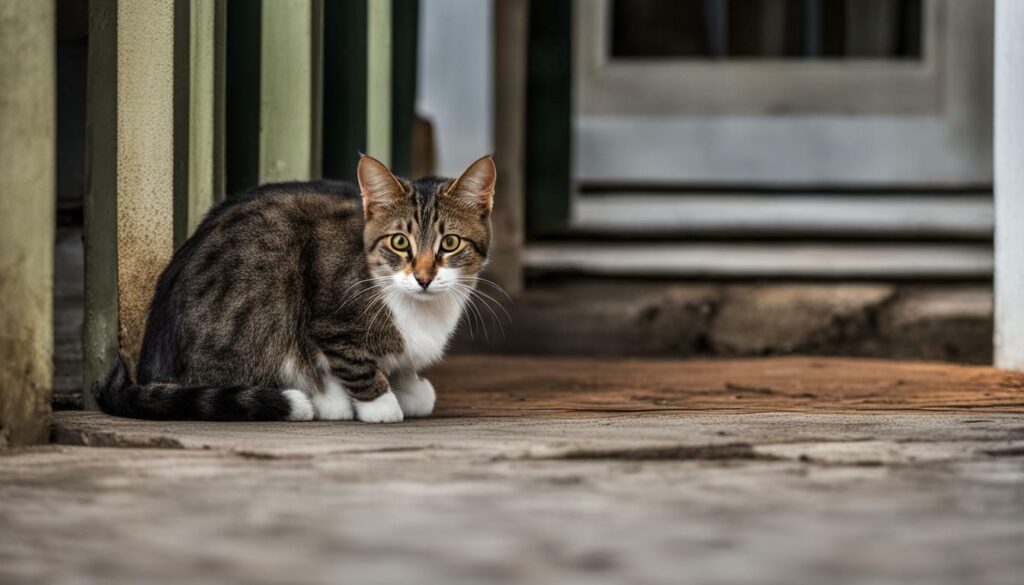Table of Contents
Stray cats are a common sight in many neighborhoods, roaming the streets in search of food and shelter. While they may seem harmless, these cats can have a significant impact on the health, behavior, and welfare of domestic cats.
It is essential to understand the implications of this issue to ensure the well-being of all cats, both stray and domestic. In this article, we will explore the impact of stray cats on domestic cats and discuss strategies for promoting coexistence and mitigating negative effects.
Key Takeaways:
- Stray cats can have a significant impact on the health, behavior, and welfare of domestic cats.
- Understanding the implications of this issue is essential for the well-being of all cats.
- This article will explore the impact of stray cats on domestic cats and discuss strategies for promoting coexistence and mitigating negative effects.
The Presence of Stray Cats and its Effects on Domestic Cats
Feral cat populations can have a significant impact on the health and well-being of domestic cats. Stray cats are known to carry a variety of diseases that can be transmitted to domestic cats, such as feline immunodeficiency virus and feline leukemia virus. This is particularly concerning for outdoor cats who are more likely to come into contact with stray cats.
In addition to disease transmission, the territorial behavior of stray cats can also affect domestic cats. Outdoor cats may feel threatened by the presence of stray cats, leading to stress and anxiety. This can cause changes in behavior, such as increased aggression or urination outside the litter box.
To promote coexistence between stray and domestic cats, it is important to manage outdoor cats effectively. This can include providing outdoor cats with their own resources, such as food and water bowls, and ensuring that they are spayed or neutered to help control the feral cat population. Additionally, indoor cats should have plenty of resources to keep them occupied and mentally stimulated, such as scratching posts and interactive toys.
| Cat Territoriality | Cat Diseases | Cat Coexistence |
|---|---|---|
| Stray cats’ territorial behavior can cause stress and anxiety in domestic cats | Stray cats can transmit diseases to domestic cats, such as feline immunodeficiency virus and feline leukemia virus | Managing outdoor cats effectively can promote peaceful coexistence between stray and domestic cats |
Overall, it is important to understand the impact of stray cats on domestic cats and take proactive measures to protect the health and well-being of all cats in the community. By managing outdoor cats effectively and promoting responsible cat ownership, we can create a safer and happier environment for cats of all kinds.
Health Risks Associated with Stray Cats for Domestic Cats
Stray cats can pose various health risks to domestic cats. They can transmit a range of diseases, including feline infectious peritonitis, feline leukemia virus, and feline immunodeficiency virus. Outdoor cats that come into contact with stray cats are more likely to contract these diseases.
It’s important to note that stray cats may not show any symptoms of infectious diseases, making it difficult to identify infected cats. Therefore, regular veterinary checkups are crucial for domestic cats to detect and treat any potential diseases early on.
Feline health can also be compromised due to exposure to environmental hazards, such as parasites and pathogens present in the feces of stray cats. Outdoor cats are more likely to encounter these risks, as they have more opportunities to come into contact with contaminated surfaces.
To protect the health of domestic cats, it’s essential to ensure that they receive proper vaccinations and routine veterinary care. Indoor cats that do not have access to outdoor environments are less likely to contract diseases from stray cats but should still be monitored for any potential health issues.
Behavioral and Social Impact of Stray Cats on Domestic Cats
The presence of stray cats can have significant behavioral and social impacts on domestic cats. Outdoor cats, whether strays or owned, can trigger territorial behavior in indoor cats, leading to stress and anxiety. Domestic cats may mark their territory by scratching or spraying urine, indicating a strong territorial claim. The presence of a stray cat in their territory could exacerbate their territorial behavior and lead to increased stress levels.
Stray cats may also trigger aggression in domestic cats, particularly during encounters at feeding stations or other commonly visited areas. In some cases, fights can lead to serious injuries and the transmission of diseases.
Moreover, the presence of stray cats can influence the overall well-being of domestic cats. For example, stray cats can cause disruptions to a cat’s daily routine and potentially disrupt their sense of safety and security. Additionally, the stress caused by a stray cat’s presence can increase the risk of a cat contracting illnesses and diseases.
To minimize these impacts, it is recommended that cat owners provide environmental enrichment for their pets, such as hiding treats and toys around the house, installing scratching posts, and creating high perches for cats to climb. These activities can help to reduce stress and anxiety in cats and provide them with a sense of control over their environment.
It is also important to implement safe management practices, such as providing outdoor cats with safe feeding stations away from the house, to prevent territorial disputes and potential fights. Additionally, keeping domestic cats up to date on their vaccinations and veterinary care can help protect their health and prevent the spread of diseases.
In cases where stray cats are causing significant disruptions or posing a danger to domestic cats, it may be necessary to seek assistance from local animal control agencies or community cat programs to address the situation.
Preventive Measures and Solutions
To mitigate the impact of stray cats on domestic cats, various preventive measures and solutions can be implemented. Firstly, spaying and neutering stray cats can help control the feral cat population and reduce the risks of disease transmission. Local animal shelters and rescue organizations often offer low-cost or free spay/neuter services for stray cats.
Managing outdoor cats is also crucial to minimize their impact on domestic cats. Owners should prioritize keeping their cats indoors or in a secure outdoor enclosure, especially at night. Feeding domestic cats indoors or away from outdoor feeding stations for strays can prevent territorial disputes and reduce the spread of diseases. Additionally, providing a safe space for outdoor cats, such as a warm shelter or a designated feeding area, can promote peaceful coexistence between cats.
Community-based initiatives and programs can also play a significant role in promoting responsible cat ownership and population control. Local governments can partner with animal advocacy groups to organize trap-neuter-return (TNR) programs, which humanely trap, sterilize, and return stray cats to their original locations. TNR programs have been shown to effectively reduce feral cat populations over time.
Ultimately, preventing and minimizing the impact of stray cats on domestic cats requires a collaborative effort among cat owners, animal welfare organizations, and local communities. By implementing these preventive measures and solutions, we can help protect the health and well-being of all cats and promote peaceful coexistence between outdoor and indoor cats.
The Impact of Stray Cats on Domestic Cats: Conclusion
Stray cats have a significant impact on the health and well-being of domestic cats. Their presence can lead to the spread of diseases, territorial conflicts, and stress among the domestic feline population. Therefore, it is crucial to understand and address this issue to promote the coexistence of stray and domestic cats while ensuring the health and welfare of the latter.
Preventive measures and solutions, such as spaying and neutering of stray cats, managing outdoor cats, and community-based initiatives, can help to mitigate the negative impact of stray cats on domestic cats. These measures can also help to control the feral cat population and promote responsible cat ownership.
In conclusion, it is essential to recognize the impact of stray cats on domestic cats and take proactive measures to ensure their well-being. By promoting coexistence and implementing preventive measures and solutions, we can create a safer and healthier environment for all feline companions.



